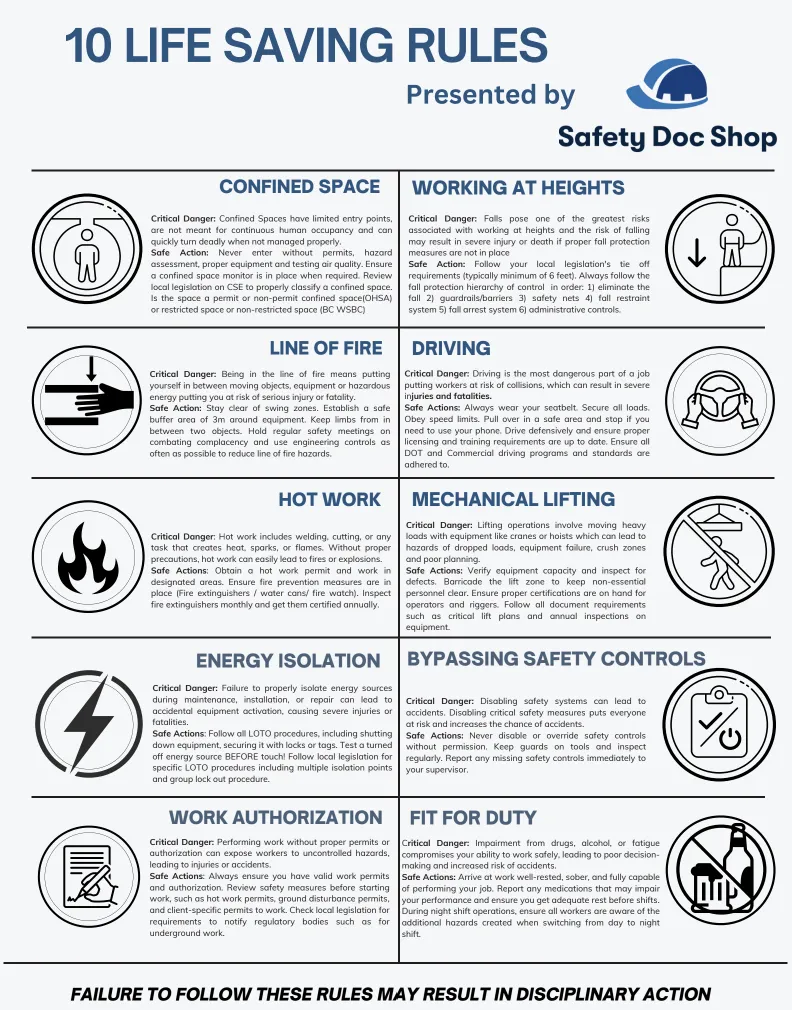Coastal Safety Consulting
780-228-6928

Articles Coastal Safety Consulting Ltd.

The 10 Life-Saving Rules: Building a Culture of Safety in the Workplace
The 10 Life-Saving Rules: Building a Culture of Safety in the Workplace
In high-risk industries, a culture of safety is not just a priority—it’s a necessity. Every day,
workers face hazards that could lead to severe injuries or fatalities if proper precautions aren’t
followed. This is where the 10 Life-Saving Rules come into play. These rules are designed to
address the most dangerous situations workers encounter, setting non-negotiable boundaries
that prioritize safety above all else. Let’s take a closer look at why these rules matter and how
they can transform a workplace into a safer environment for everyone.
Why the 10 Life-Saving Rules?
Human nature leans toward shortcuts, especially under tight deadlines or repetitive tasks. This
often leads to unsafe practices that increase risks. The 10 Life-Saving Rules act as a
psychological “red light,” guiding workers to stop and consider their actions before proceeding.
These clear boundaries simplify decision-making by reminding employees that safety cannot be
compromised, no matter the circumstances.
For instance, rules around Driving Safely ensure workers recognize that obeying speed limits
and securing loads aren’t optional—they’re essential steps that protect lives. Similarly, Energy
Isolation (LOTO) procedures prevent the accidental activation of machinery during
maintenance, which could otherwise lead to catastrophic injuries.
Core Components of the Program
The success of the 10 Life-Saving Rules relies on awareness, continuous training, compliance,
and accountability. Here’s how these key components reinforce a safe working environment:
1. Awareness and Communication:
Safety rules are formally introduced to all employees
through emails, postings, and mandatory training. By highlighting these rules during
onboarding and reinforcing them in daily meetings, workers internalize safe practices as
automatic, anchored behaviors.
2. Training:
Initial training introduces new hires to these rules and provides real-world
examples of incidents that resulted from rule violations. Ongoing training sessions,
including role-specific courses and emergency drills, ensure that employees remain up-
to-date on safety measures. For example, confined space workers learn the unique risks
they face and the critical steps to mitigate these dangers.
3. Inspections and Monitoring:
Supervisors conduct random inspections to check
compliance, and safety audits highlight improvement areas. Consistent enforcement not
only ensures adherence but also keeps safety top-of-mind in day-to-day operations.
4. Reporting and Accountability:
All incidents, including near misses, are documented,
providing valuable insights into risk areas. Violations lead to immediate corrective
actions, including retraining or, in severe cases, termination.
Building Safe Habits with the Life-Saving Rules
The 10 Life-Saving Rules use behavioral psychology principles like habit stacking to make
safety a natural part of daily work routines. By regularly emphasizing these rules in toolbox
talks, morning meetings, and safety campaigns, organizations encourage employees to
automatically consider these safety actions before engaging in any task. Over time, these
practices become second nature.
For example, in a meeting, a “Life-Saving Spotlight” might focus on Mechanical Lifting,
reminding everyone to check equipment capacity and clear non-essential personnel from the lift
zone. This habit of assessing lifting safety can drastically reduce risks associated with dropped
loads or equipment failure.
Continuous Improvement and Recognition
To sustain a culture of safety, continuous program evaluation is essential. Leadership teams
review the program annually, incorporating employee feedback, industry best practices, and
incident data to update policies. Recognition also plays a vital role; employees and teams
demonstrating exceptional adherence to these rules are acknowledged, reinforcing the
importance of these safety behaviors and fostering a positive safety culture.
The Impact of the 10 Life-Saving Rules
By committing to these rules, companies can reduce workplace incidents, protect their
workforce, and foster an environment where safety is prioritized. The 10 Life-Saving Rules are
more than guidelines—they are a foundation for sustainable, proactive safety practices.
Embracing these rules not only safeguards individual workers but also strengthens the entire
organization, creating a resilient workplace where safety is everyone’s responsibility.
Implementing the 10 Life-Saving Rules may require an initial shift in mindset, but the payoff is
invaluable: a workplace where every employee goes home safely at the end of each day. This is
the ultimate goal of any safety program, and it’s one that the 10 Life-Saving Rules are designed
to achieve.




